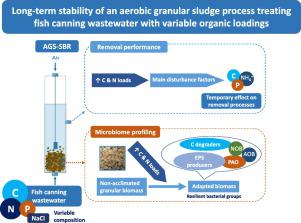Science of the Total Environment ( IF 8.2 ) Pub Date : 2020-11-21 , DOI: 10.1016/j.scitotenv.2020.144007 Ana M.S. Paulo , Catarina L. Amorim , Joana Costa , Daniela P. Mesquita , Eugénio C. Ferreira , Paula M.L. Castro

|
The tolerance of aerobic granular sludge (AGS) to variable wastewater composition is perceived as one of its greatest advantages compared to other aerobic processes. However, research studies select optimal operational conditions for evaluating AGS performance, such as the use of pre-adapted biomass and the control of wastewater composition. In this study, non-adapted granular sludge was used to treat fish canning wastewater presenting highly variable organic, nutrient and salt levels over a period of ca. 8 months. Despite salt levels up to 14 g NaCl L−1, the organic loading rate (OLR) was found to be the main factor driving AGS performance. Throughout the first months of operation the OLR was generally lower than 1.2 kg COD m−3 day−1, resulting in stable nitrification and low COD and phosphorous levels at the outlet. An increase in OLR up to 2.3 kg COD m−3 day−1 disturbed nitrification and COD and phosphate removal, but a decrease to average values between 1 and 1.6 kg COD m−3 day−1 led to resuming of these processes. Most of the bacteria present in the AGS core microbiome were associated to extracellular polymeric substances (EPS) production, such as Thauera and Paracoccus, which increased during the higher OLR period. Ammonium-oxidizing bacteria (AOB) and nitrite-oxidizing bacteria (NOB) species were detected in AGS biomass; while AOB were identified throughout the operation, NOB were no further identified after the period of increased OLR. Different polyphosphate-accumulating organisms (PAOs) were detected along the process: Candidatus Accumulibacter, Tetrasphaera and Gemmatimonas. A non-adapted granular sludge was able to treat the fish canning wastewater and to tolerate salinity fluctuations up to 14 g L−1. Overall, a high microbial diversity associated to EPS producers allowed to preserve bacterial groups responsible for nutrients removal, contributing to the adaptation and long-term stability of the AGS system.
中文翻译:

非适应性好氧颗粒污泥工艺处理核心微生物组中与EPS生产商相关的鱼罐头废水的长期稳定性
与其他好氧工艺相比,好氧颗粒污泥(AGS)对可变废水成分的耐受性被认为是其最大的优势之一。但是,研究选择了最佳的操作条件来评估AGS的性能,例如使用预先适应的生物质和控制废水成分。在这项研究中,未适应的颗粒污泥被用于处理鱼罐头废水,在一段时间内,这些废水中有机,营养和盐分含量变化很大。8个月。尽管盐含量高达14 g NaCl L -1,但发现有机负载率(OLR)是驱动AGS性能的主要因素。在运营的最初几个月中,OLR通常低于1.2 kg COD m -3天-1,导致稳定的硝化作用,出口处的COD和磷含量较低。OLR升高至2.3 kg COD m -3天-1会干扰硝化作用以及COD和磷酸盐的去除,但会降低到1至1.6 kg COD m -3天-1的平均值导致这些过程的恢复。存在于AGS核心微生物组中的大多数细菌与细胞外聚合物(EPS)的产生有关,例如Thauera和Paracoccus,它们在较高的OLR期间会增加。在AGS生物质中检测到铵氧化菌(AOB)和亚硝酸盐氧化菌(NOB)。虽然在整个手术过程中都发现了AOB,但在OLR升高后没有再发现NOB。在此过程中检测到了不同的聚磷酸盐累积生物(PAO):念珠菌,四球菌和芽孢杆菌。一种不适应的颗粒污泥能够处理鱼罐头废水并耐受高达14 g L -1的盐度波动。总体而言,与EPS生产商相关的高微生物多样性可以保留负责去除营养的细菌群,从而有助于AGS系统的适应性和长期稳定性。











































 京公网安备 11010802027423号
京公网安备 11010802027423号